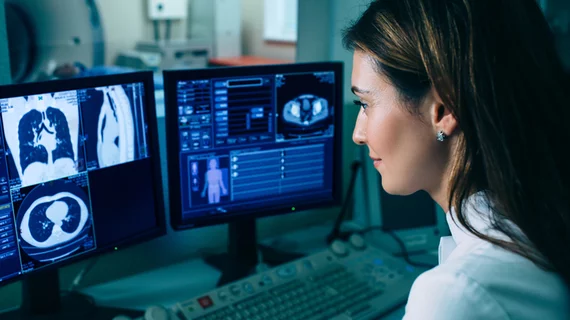Providers ordering high-cost imaging see appropriateness scores rise with widely-used support tool
Providers ordering advanced imaging through a clinical decision support mechanism notched higher appropriateness scores the more they used the tool, suggesting learning takes place with each interaction.
That’s according to data collected across more than 250 U.S. healthcare institutions over a nearly three year period, published Feb. 26 in the Journal of Digital Imaging. Providers’ scores gradually increased from their first 10 orders using the support tool to their final 10, while also pushing down the percentage of requests considered yellow ("may be appropriate") and red ("usually not appropriate").
While the findings are not an open-and-shut case showing clinical decision support automatically enhances imaging utilization, the conclusions are positive, according to Leonid L. Chepelev, MD, with Stanford University, and colleagues.
“Under the assumption that appropriateness scores rendered by the CDSM at the point of care correlate with an improvement in imaging appropriateness, the improved green and red rates support CDSM consultation for high-cost medical imaging,” the authors added.
Chepelev et al. noted this observational study is a product of the Centers for Medicare & Medicaid Services-led Demonstration Project, which took place before the federal agency mandated CDS use under a section of the Protecting Access to Medicare Act of 2014.
This research evaluated providers’ initial 200 consecutive orders for CT, MRI, ultrasound, and nuclear medicine imaging using a Change Healthcare decision support mechanism between January 2017 and December 2019. In total, 288 organizations participated, numbering 244,158 physicians and upward of 7 million imaging orders.
The group found that for the 10,000-plus providers with 200 requests or fewer, the fraction of green, yellow and red orders among the final group of 10 changed by +3%, -0.8%, and -3%, respectively, compared with the first 10 orders.
And participants with more than 190 requests had 8.5% more green orders, 2.3% fewer yellows, and 0.5% fewer red orders compared to providers with 10 requests or fewer.
“Medical imaging CDSM use was associated with an overall improvement in appropriateness scores as measured by the chronology of requisitions and the experience of the provider,” the authors explained.
Chepelev and colleagues acknowledged that improved scores may be a result of physicians “gaming” the system with “no proven impact on imaging decisions whatsoever.” At the same time, they said a more optimistic stance could be that the tool enhances decisions across the board. In their opinion, however, “the truth likely lies between these two viewpoints.”
“Future work should correlate appropriateness scores with pragmatic clinical appropriateness and outcomes, and further analyses at individual provider and individual requisition level are planned,” they concluded.

